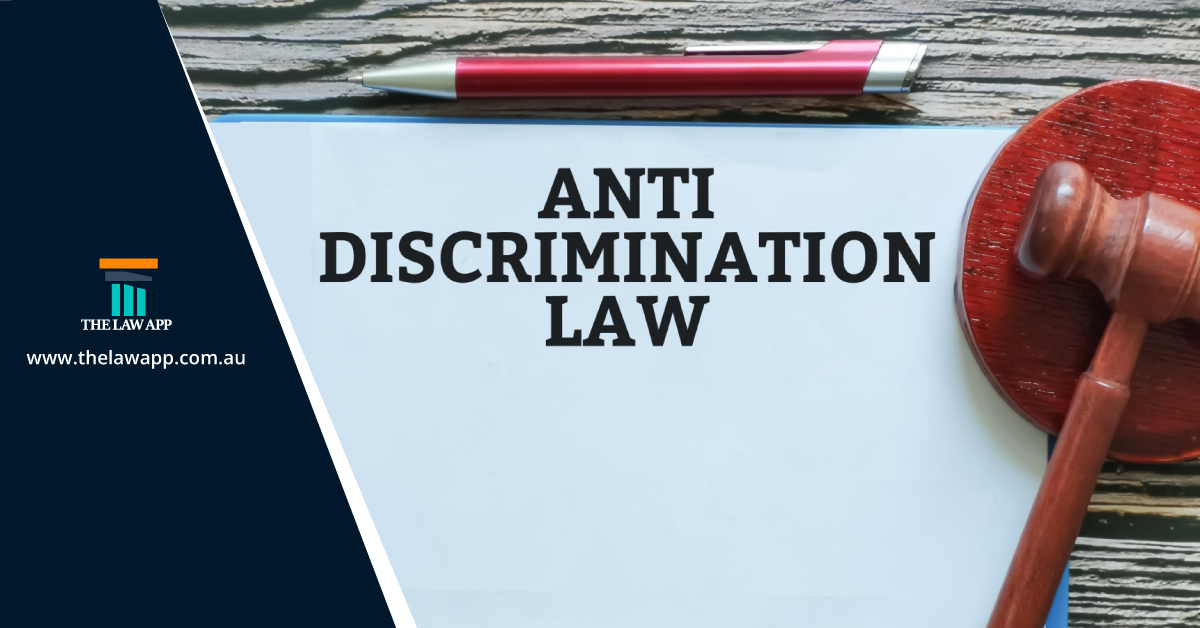
Australia stands proudly as a multicultural nation, enriched by diverse communities that contribute to its vibrant tapestry. At the heart of fostering this diversity lies the intricate web of Anti Discrimination Law. In this brief exploration, we will unravel the meaning and significance of these laws, understanding their pivotal role in shaping a fair and inclusive society.
Anti-Discrimination Laws in Australia serve as the guardians of equality, aiming to eliminate unfair treatment based on certain characteristics. These protected attributes include race, gender, age, disability, and religion. In essence, these laws form a shield against prejudice, fostering an environment where every individual is treated with dignity and respect.
 In the vast expanse of the Australian social landscape, Anti Discrimination Laws play a crucial role in fostering a culture of acceptance. By promoting equal opportunities and protecting against discrimination, these laws contribute to the creation of a society where every person, regardless of their background, can thrive and contribute meaningfully.
In the vast expanse of the Australian social landscape, Anti Discrimination Laws play a crucial role in fostering a culture of acceptance. By promoting equal opportunities and protecting against discrimination, these laws contribute to the creation of a society where every person, regardless of their background, can thrive and contribute meaningfully.
Delving into the intricate tapestry of Anti-Discrimination Laws, we unveil the threads that bind our nation together. “Breaking Down Barriers: Unraveling the Web of Anti-Discrimination Laws” serves as our guiding beacon, shedding light on the complexities of these laws and their profound impact on the Australian social fabric. Join us on this journey of exploration and enlightenment as we navigate the legal channels that uphold our commitment to equality.
Australia, with its rich cultural tapestry, is committed to fostering a society where every individual, irrespective of background, is treated fairly and respectfully. Central to this commitment are the Anti-Discrimination Laws, a legal framework designed to safeguard individuals from prejudice and discrimination. In this exploration, we’ll delve into the key components of these laws, shedding light on the protected characteristics and various forms of discrimination that weave the fabric of our inclusive nation.
Race and Ethnicity: Australia, a melting pot of cultures, recognises and protects individuals from discrimination based on their race and ethnicity. These laws stand as a shield against racial bias, fostering an environment of unity.
Gender and Sex: Upholding the principles of gender equality, Anti-Discrimination Laws safeguard individuals from discrimination based on gender or sex. This ensures equal opportunities for everyone, irrespective of gender identity.
Age: In a society that values the wisdom of experience, Anti-Discrimination Laws protect individuals from age-related bias, ensuring that age does not become a barrier to opportunities.
Disability: Australia champions inclusivity by protecting individuals with disabilities from discrimination. These laws ensure that accommodations are made to provide equal access and opportunities for everyone.
Religion: Recognising the diversity of faiths, Anti-Discrimination Laws prohibit discrimination based on religious beliefs. This protection extends to all individuals, fostering religious harmony.
Direct Discrimination: This occurs when someone is treated less favorably due to a protected characteristic. Anti-Discrimination Laws stand against such blatant biases, promoting a level playing field.
Indirect Discrimination: Recognising subtler forms of bias, these laws address situations where certain policies or practices disproportionately affect individuals with protected characteristics.
Harassment: Anti-Discrimination Laws protect individuals from any form of unwelcome conduct, ensuring a workplace and society free from harassment based on protected characteristics.
Victimisation: Individuals who stand up against discrimination are shielded from retaliation under these laws, fostering a culture where justice prevails.
In the intricate mosaic of Anti-Discrimination Laws, understanding the protected grounds is essential. “Navigating the Mosaic” unveils the complexity of these laws, emphasising the importance of recognising and respecting the diverse characteristics that shape our nation. Join us on this journey through the protected grounds, where the threads of equality weave a tapestry of inclusivity in the Australian context.
Australia’s commitment to equality is deeply embedded in the evolution of its Anti-Discrimination Laws. This journey spans decades, shaped by historical events and landmark cases that have paved the way for a more inclusive society. In this segment, we’ll embark on a historical exploration, tracing the roots of Anti-Discrimination Laws in Australia.
The origins of Australia’s Anti-Discrimination Laws can be traced back to pivotal moments in history, marked by social movements and the collective desire for a fair and just society. From the early struggles for civil rights to the acknowledgment of Indigenous rights, each phase has contributed to the development of a legal framework that champions equality.
Landmark cases stand as pillars in the evolution of Anti-Discrimination Laws. These legal battles have not only addressed specific instances of discrimination but have also set crucial precedents, influencing the interpretation and application of these laws. From cases highlighting gender discrimination to those focused on racial equality, each instance has played a role in refining the legal landscape.
“From Past to Present: Tracing the Journey of Equality Laws” encapsulates the historical voyage of Australia’s Anti-Discrimination Laws. This subheading serves as a compass, guiding us through the transformative chapters that have shaped the current legal framework. Join us in unraveling the historical tapestry that forms the backdrop of today’s commitment to equality in Australia.
 In Australia, Anti Discrimination Law extend their reach beyond the legal realm, influencing the very fabric of businesses and workplaces. These laws are instrumental in shaping an environment where diversity is celebrated, and every employee is afforded equal opportunities for growth and success.
In Australia, Anti Discrimination Law extend their reach beyond the legal realm, influencing the very fabric of businesses and workplaces. These laws are instrumental in shaping an environment where diversity is celebrated, and every employee is afforded equal opportunities for growth and success.
Anti Discrimination Law set the stage for workplace equality by prohibiting discrimination based on protected characteristics. This creates a level playing field, ensuring that employees are judged solely on their skills, qualifications, and performance. Companies that embrace workplace equality not only adhere to legal obligations but also cultivate a positive and inclusive organisational culture.
Beyond mere compliance, businesses are increasingly recognising the strategic value of diversity and inclusion. Anti Discrimination Law provide the impetus for companies to implement initiatives that actively embrace diversity, fostering an environment where employees from various backgrounds feel valued and respected. This inclusivity enhances creativity, innovation, and overall productivity within the workplace.
“Beyond Compliance: How Anti-Discrimination Laws Transform Workplaces” encapsulates the transformative impact of these laws on the business landscape. This subheading serves as a beacon, highlighting the proactive role that businesses can play in creating environments that go beyond legal requirements. Join us in exploring the ways in which Anti-Discrimination Laws are catalysts for positive change, turning workplaces into thriving hubs of diversity and inclusion in the Australian context.
While Anti-Discrimination Laws in Australia stand as pillars of equality, they are not without their share of challenges and controversies. Navigating these complexities requires a nuanced understanding of the criticisms, debates, and emerging issues that shape the ongoing discourse surrounding these crucial laws.
Anti Discrimination Law have faced scrutiny and debate, with critics questioning their effectiveness and scope. Some argue that these laws may infringe on freedom of speech or religion, while others express concerns about the potential for misuse in certain situations. Addressing these criticisms is an essential aspect of refining and strengthening the legal framework, ensuring that it strikes the right balance between protection and individual freedoms.
As society evolves, so do the challenges related to discrimination. Emerging issues, such as those pertaining to technology and artificial intelligence, add new dimensions to the conversation. The rapid pace of change requires Anti Discrimination Law to adapt and encompass these contemporary challenges to remain effective in safeguarding individuals from discrimination in all its forms.
“Balancing Act: Navigating the Controversies of Anti-Discrimination Laws” encapsulates the delicate equilibrium required to address the challenges surrounding these laws. Acknowledging the complexities of the legal landscape and the ongoing efforts to strike a balance between protection and individual liberties. Join us in navigating the controversies, recognising that the evolution of Anti-Discrimination Laws is a dynamic process aimed at creating a just and equitable Australian society.
Ensuring the efficacy of Anti-Discrimination Laws in Australia requires a robust system of enforcement and remedies. This vital aspect involves government agencies, legal recourse for victims, and the overarching commitment to serve as guardians of equality.
Australia boasts dedicated government agencies tasked with overseeing the enforcement of Anti-Discrimination Laws. These agencies play a pivotal role in investigating complaints, mediating disputes, and ensuring that organisations adhere to the prescribed standards of equality. By functioning as vigilant protectors, these agencies contribute significantly to the maintenance of a fair and just society.
Victims of discrimination find solace in the legal recourse provided by Anti-Discrimination Laws. They have the right to seek justice and restitution through legal channels, empowering them to stand against discriminatory practices. This legal recourse serves as a powerful deterrent, fostering an environment where individuals feel supported in challenging unfair treatment.
“Guardians of Equality: How Anti-Discrimination Laws are Enforced” encapsulates the proactive role played by enforcement mechanisms in upholding the principles of equality. Join us in exploring how these guardians ensure the enforcement of Anti-Discrimination Laws, shaping a landscape where equality is not just an ideal but a protected reality in the Australian context.
Australia’s commitment to Anti Discrimination Law finds resonance on the global stage, where a shared vision of inclusivity and equality is fostered. Examining international perspectives offers insights into the broader context of Anti-Discrimination Laws, encompassing an intricate interplay of human rights frameworks and cross-cultural variances.
Anti-Discrimination Laws align with the broader international human rights framework, where principles of equality, dignity, and non-discrimination are enshrined. Australia, as a signatory to various international agreements, contributes to a global effort to create a world where every individual is treated with fairness and respect, transcending borders and cultural boundaries.
While the fundamental principles of Anti-Discrimination Laws are universal, the implementation and nuances vary across cultures. Different societies bring their unique perspectives and challenges to the table. Understanding these cross-cultural variances is crucial for fostering a truly inclusive global approach to combating discrimination.
Inclusive Globe: A Worldview on Anti-Discrimination Laws”Inclusive Globe: A Worldview on Anti-Discrimination Laws” encapsulates the global perspective on combating discrimination. Join us in unraveling how Anti-Discrimination Laws contribute to creating an inclusive globe, where the shared values of equality and diversity transcend geographic boundaries.
 As we navigate the complexities of the present, it’s essential to cast our gase toward the future of Anti-Discrimination Laws in Australia. Anticipating the impact of technological advancements and legislative changes is integral to ensuring that these laws remain dynamic, responsive, and effective in fostering a society where equality thrives.
As we navigate the complexities of the present, it’s essential to cast our gase toward the future of Anti-Discrimination Laws in Australia. Anticipating the impact of technological advancements and legislative changes is integral to ensuring that these laws remain dynamic, responsive, and effective in fostering a society where equality thrives.
The advent of technology introduces new dimensions to the landscape of discrimination. From algorithmic biases to digital surveillance, the technological realm poses challenges that demand careful consideration. Future trends in Anti-Discrimination Laws will likely involve adapting to these technological nuances, ensuring that protections extend to the digital spaces where modern life unfolds.
Legislation is a living entity, subject to change in response to societal shifts. Future developments in Anti-Discrimination Laws will likely be shaped by evolving understandings of equality and justice. Legislative changes may emerge to address emerging forms of discrimination, ensuring that the legal framework remains aligned with the values and needs of the Australian populace.
“Tomorrow’s Equality: Anticipating the Future of Anti-Discrimination Laws” serves as a forward-looking guide to the evolution of these laws. Join us in exploring how these laws are poised to shape the landscape of equality in Australia for generations to come.
As we draw the curtains on our exploration of Anti-Discrimination Laws in Australia, it’s crucial to reflect on the key insights uncovered throughout our journey. From the historical roots to the global perspectives and future trends, these laws stand as sentinels guarding Australia’s commitment to a society where every individual is treated with dignity and respect.
We began by unraveling the intricate tapestry of Anti-Discrimination Laws, understanding their definition and significance in Australian society. Navigating through the protected characteristics, types of discrimination, and historical evolution, we witnessed the transformative impact of these laws on workplaces, businesses, and the global stage.
As we conclude, the call to action resounds loudly. Achieving a discrimination-free future requires a collective effort. Individuals, businesses, and policymakers all play vital roles in upholding the principles of equality. Let us embrace diversity, challenge discrimination wherever it lurks, and actively contribute to fostering an inclusive and harmonious Australia.
“Building Bridges, Breaking Chains: Embracing a Discrimination-Free Future” encapsulates our collective vision for the times ahead. Together, let’s build bridges of understanding and break the chains of discrimination, paving the way for a future where Australia stands as a shining example of equality and respect.
The Law App is a complete online marketplace for people to search for lawyers at a price they can afford and for lawyers to build an online presence to find clients without the need for heavy marketing expenses. We match clients to lawyers directly based on their field of expertise and allow fair bidding to reach the right price.
Anti-Discrimination Law refers to legislation designed to prevent unfair treatment based on protected characteristics. In Australia, it safeguards against discrimination in various aspects of life.
Anti-Discrimination Laws protect attributes like race, gender, age, disability, and religion. These laws aim to create a society where everyone is treated fairly and without prejudice.
These laws promote workplace equality, encouraging businesses to implement diversity and inclusion initiatives. Compliance ensures a fair and inclusive working environment.
Absolutely. Landmark cases set legal precedents, influencing the interpretation and application of these laws. They play a vital role in shaping the evolution of Anti-Discrimination Laws.
Government agencies oversee enforcement, investigating complaints and mediating disputes. They act as vigilant protectors, ensuring organisations adhere to equality standards.
Criticisms range from concerns about freedom of speech to debates on misuse. Emerging issues, including those related to technology, add new dimensions to the ongoing discourse.
The future involves adapting to technological impacts and legislative changes. Anticipating these trends ensures that Anti-Discrimination Laws remain effective in fostering a discrimination-free society.